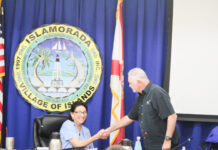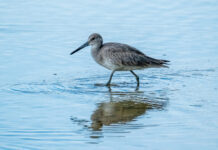It was late in the day and Kevin Christman was leaving the Keys, not for the weekend, but for good – boxes packed, small dog in his lap, on his way to his new home in Gainesville – when he saw the booby on the side of the road on Bahia Honda, just outside the state park entrance. He stopped and took a couple photos, and texted a few members of the local bird mafia with a picture of the bird, a pin on a map, and the words “right now.”
Boobies stand about 2 feet tall, but they don’t stand that often. They are pelagic birds of the deep ocean, and they spend most of their lives flying or floating. They do not resemble human mammaries in any way, unless you consider their pointed bills reminiscent of Madonna’s cone-shaped bra era, but people still make the titillating jokes. Because most people are third graders at heart.
Boobies got the name because they tend to breed on predator-free desert islands and often don’t have fight-or-flight instincts. In days of yore, sailors would walk right up to them and conk them on the heads with cudgels, clubs, or whatever blunt instrument was available. The word booby, in the sailor lingo of the time, meant stupid.
Whichever species Kevin saw, no doubt it had been brought in by Idalia. Since the storm passed, rare birds had been reported all over Florida – though nearly all of them were American flamingos.
Looking at Kevin’s photo, the bird was mostly brown, making it a juvenile, and narrowing it down to two possibilities – a brown booby, which you can see pretty easily if you go out to the Dry Tortugas, as well as on the occasional channel marker, or a red-footed booby, which would be a pretty serious rarity.
I saw a red-footed booby once out at the Dry Tortugas, but the bird was about a half-mile away in blanching, glaring sunlight and I was looking through a wind-shaken spotting scope, which made the world look as if it was enduring a prolonged earthquake. There were other field marks, but the main clue for the bird was the nominate red feet, which were really hard to see at that distance, and it took a while to feel confident about it, though eventually I mostly did. But I was really interested in getting another, better look.
Kevin being on the move, the picture he sent was an iPhone photo of the screen on the back of his “real” camera – not an uncommon thing in the birding world, where people often want to get information out quickly. In that photo, the booby looked like it had red feet. Or reddish. Or at least you couldn’t eliminate the possibility of red feet. Maybe they were orange? No, they were definitely red. But maybe not that red. Colors can get a little funky in a picture of a picture.
Still, I texted Ellen Westbrook and Mark Whiteside and said there was a possible red-footed booby up the Keys and did they want to go with me. They both said heck yeah, or something to that effect. So then I started packing up my gear – binoculars, camera, Nalgene bottle with drawings of hawks all over it.
Kevin pulled over and texted a few more photos on his way out of the Keys. In them you could see a bit of a demarcation, a subtle tonal change, between the brown of the breast and throat and the brown of the belly. And adult brown boobies have an abrupt color change between the brown of the breast and throat and the white of their bellies. And this bird could be on its way to molting that way.
As I was heading out the door Kevin sent another text. Mariah Hryniewich and Gianna Arcuri from the Florida Keys Hawkwatch at Curry Hammock State Park had gone down to see the bird and it was definitely the more common (but not that common) brown booby. Also, the bird had a broken wing, which explained why it was sitting by the side of U.S.1, when it should be out skimming over the ocean. They had managed to wrap the bird in a shirt, and were taking it up to Kelly Grinter at the Marathon Wild Bird Center.
I texted Mark and Ellen and said game off, there was nothing to chase. Then, five minutes later, I texted them again and asked, “Want to go look for flamingos?” Both of them said heck yeah, or something to that effect.
We started looking on Rockland Key, which has a lot of salt ponds — the hyper-saline habitat American flamingos really like. We eyed everything we could as we cruised through the Saddlebunches, and drove the length of Sugarloaf Boulevard, stopping at Sammy Creek Landing to scan out over the water toward American Shoal Lighthouse. (There had been a flamingo right off shore there a few years ago.)
We kept going up to Blimp Road on Cudjoe, then to Middle Torch. We saw gray kingbirds that still hadn’t migrated, great egrets and tri-colored herons, which are here year-round, and belted kingfishers, just back from the northlands. We saw magnificent frigatebirds sitting on the highest of the power lines, dozens if not hundreds of double-crested cormorants, and a dozen or so northern cardinals, back in places I hadn’t really seen them since Hurricane Irma in 2017.
We continued on to Big Torch, where we saw three or four Key deer bucks with fuzz still on their antlers, as well as several does and two or three absolutely adorable fawns, and one distant, scrawny raccoon running across the road. We made it down to the ponds where Christina Wilson spotted six American flamingos in the first months of the pandemic, one of which hung around for several weeks.
The sun was setting when we hit the end of the road and turned around, the sky turning the color of a blood orange.
We’d made all that effort, and all we saw was a lot of everyday Florida Keys nature. A total waste of time. Unless you like that sort of thing.






















